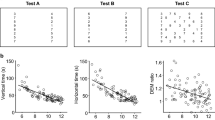Abstract
This cross-sectional study used saccadic eye movements, as measured by infrared occulography, to assess several aspects of visuospatial attention in normal children ages 8–15 years. Saccadic latency (a global measure of the ability to shift visuospatial attention), the ability to suppress extraneous saccades during fixation, and the ability to inhibit task-provoked anticipatory saccades all improve with age. However, the pattern of development differs for different tasks; saccadic latency shortens at a linear rate across the age range 8–15 years, while the capacity to inhibit anticipatory saccades matures by 12–13 years of age, and the ability to suppress saccades matures by 10 years of age. Analyses of age-related changes in oculomotor measures of attention may provide a novel approach in the study of children with attentional difficulties.
Similar content being viewed by others
References
Anderson, J. C., Williams, S., McGee, R., & Silva, P. A. (1987). DSM-III disorders in pre-adolescent children.Archives of General Psychiatry, 44, 69–76.
Becker, W. (1989). Metrics. In R. H. Wurtz, & M. E. Goldberg (Eds.),The neurobiology of saccadic eye movements (pp. 13–68). Amsterdam, The Netherlands: Elsevier Science Publishers, B. V.
Bird, H. R., Canino, G., Rubio-Stipee, M., Gould, M. S., Ribera, J., Sesman, M., Woodbury, M., Huertas-Goldman, S., Pagan, A., Sanchez-Lacy, A., & Moscoso, M. (1988). Estimates of the prevalence of childhood maladjustment in a community survey in Puerto Rico.Archives of General Psychiatry, 45, 1120–1126.
Cohen, D. J., Riddle, M. A., & Leckman, J. F. (1992). Pharmacotherapy of Tourette's syndrome and associated disorders.Psychiatric Clinics of North America, 15, 109–129.
Cohen, M. E., & Ross, L. E. (1977). Saccade latency in children and adults.Journal of Experimental Child Psychology, 23, 539–549.
Draper, N. R., & Smith, H. (1981).Applied regression analysis (2nd ed.) New York: John Wiley and Sons.
Fischer, B., & Breitmeyer, B. (1987). Mechanisms of visual attention revealed by saccadic eye movements.Neuropsychobgia, 25, 73–83.
Hommer, D. W., Clem, T., Litman, R., & Pickar, D. (1991). Maladaptive anticipatory saccades in schizophrenia.Biological Psychiatry, 30, 779–794.
Kowler, E., & Martins, A. (1982). Eye movements of preschool children.Science, 215, 997–999.
Leigh, R. J., & Zee, D. S.The neurology of eye movements (2nd ed., pg. 405). Philadelphia: F. A. Davis Company.
Mayfrank, L., Mobashery, M., Kimmig, H., & Fischer, B. (1986). The role of fixation and visual attention in the occurrence of express saccades in man.European Archives of Psychiatry and Neurological Science, 235, 269–275.
Miller, L. K. (1969). Eye-movement latency as a function of age, stimulus uncertainty, and position in the visual field.Perceptual and Motor Skills, 28, 631–636.
Miller, R. G. Jr. (1981).Simultaneous statistical inference. New York: Springer-Verlag.
Nickoloff, S. E., Radant, A. D., Reichler, R., & Hommer, D. W. (1991). Smooth pursuit and saccadic eye movements and neurological soft signs in obsessive-compulsive disorder.Psychiatry Research, 38, 173–185.
Paus, T. (1989). The development of sustained attention in children might be related to the maturation of frontal cortical functions.Acta Neurobiologiae Experimentalis (Warsaw), 49, 51–55.
Paus, T., Babenko, V., & Radil, T. (1990). Development of an ability to maintain verbally instructed central gaze fixation studied in 8-to 10-year-old children.International Journal of Psychophysiology, 10, 53–61.
Posner, M. I.(1980). Orienting of attention.Quarterly Journal of Experimental Psychology, 32, 3–25.
Posner, M. I., Walker, J. A., Friedrich, F. J., & Rafal, R. D. (1984). Effects of parietal injury on covert orienting of attention.Journal of Neuroscience, 4, 1863–1874.
Posner, M. I., & Peterson, S. E. (1990). The attention system of the human brain.Annual Review of Neuroscience, 13, 25–42.
Radant, A. D., & Hommer, D. W. (1992). A quantitative analysis of saccades and smooth pursuit during visual pursuit tracking: A comparison of schizophrenics with normals and substance abusing controls.Schizophrenia Research, 6, 225–235.
Ross, R. G., Radant, A. D., & Hommer, D. W. (1993). A developmental study of smooth pursuit eye movements in normal children from 7 to 15 years of age.Journal of the American Academy Child and Adolescent Psychiatry, 32, 783–791.
Ross, S. M., & Ross, L. E. (1983). The effects of onset and offset warning and post-target stimuli on the saccade latency of children and adults.Journal of Experimental Child Psychology, 36, 340–355.
Ross, S. M., & Ross, L. E. (1987). Children's and adults' predictive saccades to square-wave targets.Vision Research, 27, 2177–2180.
Scheffe, H. (1959).The analysis of variance. New York: Wiley.
Seber, G. A. F., & Wild, C. J. (1989).Nonlinear regression. New York: Wiley.
Streissguth, A. P., Martin, D. C., Bart, H. M., Sandman, B. M., Kirchner, G. L., & Darby, B. L. (1984). Intrauterine alcohol and nicotine exposure: Attention and reaction time in 4-year-old children.Developmental Psychology, 20, 533–541.
Swanson, J. M., Posner, M. P., Potkin, S., Bonforte, S., Youpa, D., Fiore, C., Cantwell, D., & Crinella, F. (1991). Activating tasks for the study of visual-spatial attention in ADHD children: A cognitive approach.Journal of Child Neurology, 6 (Suppl.) S117-S125.
Weschler, D. (1974).Weschler Intelligence Scale for Children-Revised. San Antonio, TX: Harcourt Brace Jovanovich.
Young, D. A. (1992).Simultaneous confidence intervals for functions of the parameters of a nonlinear mixed-effects model. Unpublished doctoral thesis, Department of Preventive Medicine and Biometrics, University of Colorado Medical School, Denver.
Zerbe, G. O., Archer, P. G., Banchero, N., & Lechner, A. J. (1982). On comparing regression lines with unequal slopes.American Journal of Physiology, 242, R178–180.
Author information
Authors and Affiliations
Rights and permissions
About this article
Cite this article
Ross, R.G., Radant, A.D., Hommer, D.W. et al. Saccadic eye movements in normal children from 8 to 15 years of age: A developmental study of visuospatial attention. J Autism Dev Disord 24, 413–431 (1994). https://doi.org/10.1007/BF02172126
Issue Date:
DOI: https://doi.org/10.1007/BF02172126




